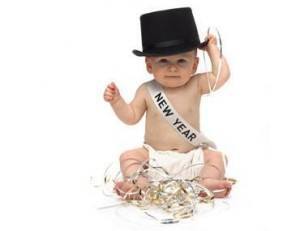 New Years Traditions
New Years Traditions
Source: Love To Know, History.com
Are wondering where the Baby New Year origin begins? Most people think of a little baby wearing only a diaper, sash and top hat upon his head smiling while bringing in the New Year. Modern times have brought more to the meaning of Baby New Year than a cute little baby”.
The Origins of Baby New Year
New Year’s represents the change of the year, in that twelve months have passed and dates back 4000 years.
Ancient Greek Baby New Year
Baby New Year origins began in 600 B.C. with the Greeks, though the early Egyptians can also be given credit for using a baby as a symbol of a new year.
The baby represents rebirth. The Greeks believed that their god of Wine, Dionysus, was reborn on New Year’s as the spirit of fertility. They would parade around with a baby in a basket to represent the rebirth of Dionysus.
Early Christian Baby New Year
Even though Christians felt this was a pagan tradition and denounced using a baby to bring in the New Year, the popularity of the symbol won, though differently than was intended. The end of the year is commemorated with a different baby as the birth of baby Jesus became a special celebration.
Modern American New Year’s Baby
In modern America, the New Year’s Baby was popularized by a series of covers for The Saturday Evening Post created by Joseph Christian Leyendecker. From 1907 to 1943 he made over 300 covers each depicting a baby and a timely cultural topic.
Meaning of Baby New Year
Baby New Year represents “in with the new, out with the old.” You may have seen cartoons showing Father Time depicted as an old man with a long gray beard. The story goes that Baby New Year will grow throughout the year into Father Time. At the end of the year, Father Time will hand over his responsibilities to the next Baby New Year.
New Year’s History: Festive Facts
What does “Auld Lang Syne” mean, and why do we sing the song at midnight on New Year’s Eve?
“Auld Lang Syne,” the title of a Scottish folk song that many English speakers sing at the stroke of midnight on New Year’s Eve, roughly translates to “days gone by.” The poet Robert Burns is credited with transcribing, adapting and partially rewriting it in the late 18th century. Its lyrics, which rhetorically ask whether “auld acquaintance” should “be forgot,” have been interpreted as a call to remember friends and experiences from the past.
Though sung on New Year’s Eve since the mid-19th century, it became firmly cemented as a holiday standard when Guy Lombardo and the Royal Canadians played it during a radio broadcast from New York’s Roosevelt Hotel at midnight on December 31, 1929. The band went on to perform the hit every year until 1976, and loudspeakers continue to blast their rendition after the annual ball drop in Times Square.
Who were the first to make resolutions for the new year?
People have been pledging to change their ways in the new year—whether by getting in shape, quitting a bad habit or learning a skill—for an estimated 4,000 years now. The tradition is thought to have first caught on among the ancient Babylonians, who made promises in order to earn the favor of the gods and start the year off on the right foot. (They would reportedly vow to pay off debts and return borrowed farm equipment.)
When was the first New Year’s Eve ball dropped in New York’s Times Square?
An estimated 1 billion people around the world watch each year as a brightly lit ball descends down a pole atop the One Times Square building at midnight on New Year’s Eve. The world-famous celebration dates back to 1904, when the New York Times newspaper relocated to what was then known as Longacre Square and convinced the city to rename the neighborhood in its honor. At the end of the year, the publication’s owner threw a raucous party with an elaborate fireworks display.
When the city banned fireworks in 1907, an electrician devised a wood-and-iron ball that weighed 700 pounds, was illuminated with 100 light bulbs and was dropped from a flagpole at midnight on New Year’s Eve. Lowered almost every year since then, the iconic orb has undergone several upgrades over the decades and now weighs in at nearly 12,000 pounds. In more recent years, various towns and cities across America have developed their own versions of the Times Square ritual, organizing public drops of items ranging from pickles (Dillsburg, Pennsylvania) to possums (Tallapoosa, Georgia) at midnight on New Year’s Eve.
What are some traditional New Year’s foods?
At New Year’s Eve parties and celebrations around the world, revelers enjoy meals and snacks thought to bestow good luck for the coming year. In Spain and several other Spanish-speaking countries, people bolt down a dozen grapes—symbolizing their hopes for the months ahead—right before midnight.
In many parts of the world, traditional New Year’s dishes feature legumes, which are thought to resemble coins and herald future financial success; examples include lentils in Italy and black-eyed peas in the southern United States.
Because pigs represent progress and prosperity in some cultures, pork appears on the New Year’s Eve table in Cuba, Austria, Hungary, Portugal and other countries.
Ring-shaped cakes and pastries, a sign that the year has come full circle, round out the feast in the Netherlands, Mexico, Greece and elsewhere. In Sweden and Norway, meanwhile, rice pudding with an almond hidden inside is served on New Year’s Eve; it is said that whoever finds the nut can expect 12 months of good fortune.

